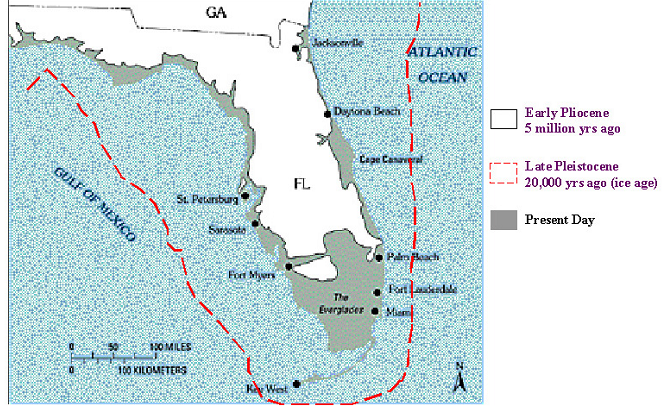Written by the TreasureGuide for the exclusive use of treasurebeachesreport.blogspot.com.
 |
| Florida's Changing Coastline. |
Beaches move. Beach sand moves constantly. It is a complex choreography with countless moving grains - some moving in one direction and others moving in another direction - some moving rapidly and some moving slowly.
Sand is moved by wind and water. I'm sure that doesn't surprise you, but the consequences are important for the beach hunter.
People talk about how items sink on a beach. As I've argued before, items on a beach rarely move if the sand doesn't move. Prove it for yourself. Get a bucket of sand, put a coin on the top of the sand, and you'll be able to observe that a coin won't sink in resting sand. Coins don't work their way down into
If I wanted to find old things at the beach, one thing I'd really like to know is the history of the beach and how it has moved over time. The beach won't be where it used to be. The sand will come and go many times in a year. Beach could be a long distance from where it used to be. And even when the surface looks the same, the sand could have eroded several times and then filled again. As that happens, objects will generally tend to settle lower.
I can remember times when local different Treasure Coast beaches were very different from what they are like today. I'm sure you can too. I remember, for example, when an old concrete foundation was exposed at the water's edge between John Brooks beach and the condos to the north. I only saw it once, but I'm sure it is still there. Of course the waterline is not where it was then. In the same area, there was also once a line of tree stumps in the shallow water. I haven't seen them again either. The water line at that time was much closer to the condos than it is today.
I'd love nothing more than to have a overhead stop-motion video history of the beach changes. You'd see the beach move in and out, slowly sometimes and at other times very quickly.
People often use stationary landmarks to judge beach changes and determine when old items might appear. It wasn't long ago that I posted how people used a car frame up by Vero to judge when hunting would be good. That car frame is gone now, but it provided a marker to estimate the movement of sand.
The illustration at the top of the post shows how much the Florida coastline has changed. It changes year to year to, and even day to day. Those changes are important to the beach hunter. Many old objects that were once in the water are now covered by the beach, and other objects that were once on the beach are now in the water.
The beach can change quickly when there is a big storm. Here are some photos of changes caused by hurricane Michael that did so much damage not too long ago.
The photos show how one section of beach disappeared in a very short time. Here is the link for more about that.
https://www.usgs.gov/news/and-after-coastal-change-caused-hurricane-michael
Here is another example from the same article.
These changes caused by Michael are easy to see. Most of the time the movement of sand occurs more slowly, but it does occur nearly continually. I'm sure that some of the erosion that occurred during Michael has been reversed by now.
I'm often amazed that people, sometimes conducting very big operations, are so far off simply because they failed to take into account beach movement. Remember, the beach is now different than it was a year ago, ten years ago, and certainly hundreds of years ago.
One of my old favorite shallow water hunting spots is now under the beach and the new waterline is out at least a hundred yards from where I hunted in the water about thirty years ago. A beach renourishment project caused that. If I went back there today and walked out into the shallow water, I'd be far from the area where I used to hunt and the old stuff would be deeply buried under the beach.
If you have a beach target that is dated to a general time period, one of the first things I'd recommend is that you do some research and try to find maps from that time and figure out where the beach was then relative to where it is now.
---
A six to nine foot surf is predicted for Friday. That is a bit of an increase since yesterday. It could get interesting.
 |
| Source: MagicSeaWeed.com. |
Happy Thanksgiving,
TreasureGuide@comcast.net

